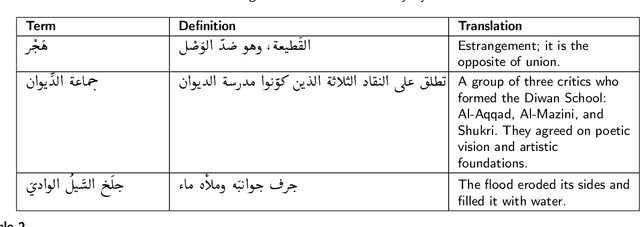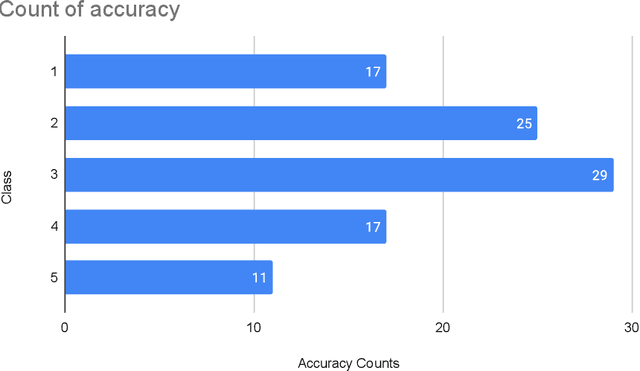Adel Ammar
SARD: A Large-Scale Synthetic Arabic OCR Dataset for Book-Style Text Recognition
May 30, 2025Abstract:Arabic Optical Character Recognition (OCR) is essential for converting vast amounts of Arabic print media into digital formats. However, training modern OCR models, especially powerful vision-language models, is hampered by the lack of large, diverse, and well-structured datasets that mimic real-world book layouts. Existing Arabic OCR datasets often focus on isolated words or lines or are limited in scale, typographic variety, or structural complexity found in books. To address this significant gap, we introduce SARD (Large-Scale Synthetic Arabic OCR Dataset). SARD is a massive, synthetically generated dataset specifically designed to simulate book-style documents. It comprises 843,622 document images containing 690 million words, rendered across ten distinct Arabic fonts to ensure broad typographic coverage. Unlike datasets derived from scanned documents, SARD is free from real-world noise and distortions, offering a clean and controlled environment for model training. Its synthetic nature provides unparalleled scalability and allows for precise control over layout and content variation. We detail the dataset's composition and generation process and provide benchmark results for several OCR models, including traditional and deep learning approaches, highlighting the challenges and opportunities presented by this dataset. SARD serves as a valuable resource for developing and evaluating robust OCR and vision-language models capable of processing diverse Arabic book-style texts.
GATE: General Arabic Text Embedding for Enhanced Semantic Textual Similarity with Matryoshka Representation Learning and Hybrid Loss Training
May 30, 2025Abstract:Semantic textual similarity (STS) is a critical task in natural language processing (NLP), enabling applications in retrieval, clustering, and understanding semantic relationships between texts. However, research in this area for the Arabic language remains limited due to the lack of high-quality datasets and pre-trained models. This scarcity of resources has restricted the accurate evaluation and advance of semantic similarity in Arabic text. This paper introduces General Arabic Text Embedding (GATE) models that achieve state-of-the-art performance on the Semantic Textual Similarity task within the MTEB benchmark. GATE leverages Matryoshka Representation Learning and a hybrid loss training approach with Arabic triplet datasets for Natural Language Inference, which are essential for enhancing model performance in tasks that demand fine-grained semantic understanding. GATE outperforms larger models, including OpenAI, with a 20-25% performance improvement on STS benchmarks, effectively capturing the unique semantic nuances of Arabic.
Pearl: A Multimodal Culturally-Aware Arabic Instruction Dataset
May 28, 2025Abstract:Mainstream large vision-language models (LVLMs) inherently encode cultural biases, highlighting the need for diverse multimodal datasets. To address this gap, we introduce Pearl, a large-scale Arabic multimodal dataset and benchmark explicitly designed for cultural understanding. Constructed through advanced agentic workflows and extensive human-in-the-loop annotations by 45 annotators from across the Arab world, Pearl comprises over K multimodal examples spanning ten culturally significant domains covering all Arab countries. We further provide two robust evaluation benchmarks Pearl and Pearl-Lite along with a specialized subset Pearl-X explicitly developed to assess nuanced cultural variations. Comprehensive evaluations on state-of-the-art open and proprietary LVLMs demonstrate that reasoning-centric instruction alignment substantially improves models' cultural grounding compared to conventional scaling methods. Pearl establishes a foundational resource for advancing culturally-informed multimodal modeling research. All datasets and benchmarks are publicly available.
Advancing Arabic Reverse Dictionary Systems: A Transformer-Based Approach with Dataset Construction Guidelines
Apr 30, 2025



Abstract:This study addresses the critical gap in Arabic natural language processing by developing an effective Arabic Reverse Dictionary (RD) system that enables users to find words based on their descriptions or meanings. We present a novel transformer-based approach with a semi-encoder neural network architecture featuring geometrically decreasing layers that achieves state-of-the-art results for Arabic RD tasks. Our methodology incorporates a comprehensive dataset construction process and establishes formal quality standards for Arabic lexicographic definitions. Experiments with various pre-trained models demonstrate that Arabic-specific models significantly outperform general multilingual embeddings, with ARBERTv2 achieving the best ranking score (0.0644). Additionally, we provide a formal abstraction of the reverse dictionary task that enhances theoretical understanding and develop a modular, extensible Python library (RDTL) with configurable training pipelines. Our analysis of dataset quality reveals important insights for improving Arabic definition construction, leading to eight specific standards for building high-quality reverse dictionary resources. This work contributes significantly to Arabic computational linguistics and provides valuable tools for language learning, academic writing, and professional communication in Arabic.
ArabianGPT: Native Arabic GPT-based Large Language Model
Feb 26, 2024Abstract:The predominance of English and Latin-based large language models (LLMs) has led to a notable deficit in native Arabic LLMs. This discrepancy is accentuated by the prevalent inclusion of English tokens in existing Arabic models, detracting from their efficacy in processing native Arabic's intricate morphology and syntax. Consequently, there is a theoretical and practical imperative for developing LLMs predominantly focused on Arabic linguistic elements. To address this gap, this paper proposes ArabianGPT, a series of transformer-based models within the ArabianLLM suite designed explicitly for Arabic. These models, including ArabianGPT-0.1B and ArabianGPT-0.3B, vary in size and complexity, aligning with the nuanced linguistic characteristics of Arabic. The AraNizer tokenizer, integral to these models, addresses the unique morphological aspects of Arabic script, ensuring more accurate text processing. Empirical results from fine-tuning the models on tasks like sentiment analysis and summarization demonstrate significant improvements. For sentiment analysis, the fine-tuned ArabianGPT-0.1B model achieved a remarkable accuracy of 95%, a substantial increase from the base model's 56%. Similarly, in summarization tasks, fine-tuned models showed enhanced F1 scores, indicating improved precision and recall in generating concise summaries. Comparative analysis of fine-tuned ArabianGPT models against their base versions across various benchmarks reveals nuanced differences in performance, with fine-tuning positively impacting specific tasks like question answering and summarization. These findings underscore the efficacy of fine-tuning in aligning ArabianGPT models more closely with specific NLP tasks, highlighting the potential of tailored transformer architectures in advancing Arabic NLP.
Prediction of Arabic Legal Rulings using Large Language Models
Oct 16, 2023



Abstract:In the intricate field of legal studies, the analysis of court decisions is a cornerstone for the effective functioning of the judicial system. The ability to predict court outcomes helps judges during the decision-making process and equips lawyers with invaluable insights, enhancing their strategic approaches to cases. Despite its significance, the domain of Arabic court analysis remains under-explored. This paper pioneers a comprehensive predictive analysis of Arabic court decisions on a dataset of 10,813 commercial court real cases, leveraging the advanced capabilities of the current state-of-the-art large language models. Through a systematic exploration, we evaluate three prevalent foundational models (LLaMA-7b, JAIS-13b, and GPT3.5-turbo) and three training paradigms: zero-shot, one-shot, and tailored fine-tuning. Besides, we assess the benefit of summarizing and/or translating the original Arabic input texts. This leads to a spectrum of 14 model variants, for which we offer a granular performance assessment with a series of different metrics (human assessment, GPT evaluation, ROUGE, and BLEU scores). We show that all variants of LLaMA models yield limited performance, whereas GPT-3.5-based models outperform all other models by a wide margin, surpassing the average score of the dedicated Arabic-centric JAIS model by 50%. Furthermore, we show that all scores except human evaluation are inconsistent and unreliable for assessing the performance of large language models on court decision predictions. This study paves the way for future research, bridging the gap between computational linguistics and Arabic legal analytics.
License Plate Super-Resolution Using Diffusion Models
Sep 21, 2023



Abstract:In surveillance, accurately recognizing license plates is hindered by their often low quality and small dimensions, compromising recognition precision. Despite advancements in AI-based image super-resolution, methods like Convolutional Neural Networks (CNNs) and Generative Adversarial Networks (GANs) still fall short in enhancing license plate images. This study leverages the cutting-edge diffusion model, which has consistently outperformed other deep learning techniques in image restoration. By training this model using a curated dataset of Saudi license plates, both in low and high resolutions, we discovered the diffusion model's superior efficacy. The method achieves a 12.55\% and 37.32% improvement in Peak Signal-to-Noise Ratio (PSNR) over SwinIR and ESRGAN, respectively. Moreover, our method surpasses these techniques in terms of Structural Similarity Index (SSIM), registering a 4.89% and 17.66% improvement over SwinIR and ESRGAN, respectively. Furthermore, 92% of human evaluators preferred our images over those from other algorithms. In essence, this research presents a pioneering solution for license plate super-resolution, with tangible potential for surveillance systems.
Early Detection of Red Palm Weevil Infestations using Deep Learning Classification of Acoustic Signals
Aug 30, 2023Abstract:The Red Palm Weevil (RPW), also known as the palm weevil, is considered among the world's most damaging insect pests of palms. Current detection techniques include the detection of symptoms of RPW using visual or sound inspection and chemical detection of volatile signatures generated by infested palm trees. However, efficient detection of RPW diseases at an early stage is considered one of the most challenging issues for cultivating date palms. In this paper, an efficient approach to the early detection of RPW is proposed. The proposed approach is based on RPW sound activities being recorded and analyzed. The first step involves the conversion of sound data into images based on a selected set of features. The second step involves the combination of images from the same sound file but computed by different features into a single image. The third step involves the application of different Deep Learning (DL) techniques to classify resulting images into two classes: infested and not infested. Experimental results show good performances of the proposed approach for RPW detection using different DL techniques, namely MobileNetV2, ResNet50V2, ResNet152V2, VGG16, VGG19, DenseNet121, DenseNet201, Xception, and InceptionV3. The proposed approach outperformed existing techniques for public datasets.
ERA*: Enhanced Relaxed A* algorithm for Solving the Shortest Path Problem in Regular Grid Maps
Aug 15, 2023Abstract:This paper introduces a novel algorithm for solving the point-to-point shortest path problem in a static regular 8-neighbor connectivity (G8) grid. This algorithm can be seen as a generalization of Hadlock algorithm to G8 grids, and is shown to be theoretically equivalent to the relaxed $A^*$ ($RA^*$) algorithm in terms of the provided solution's path length, but with substantial time and memory savings, due to a completely different computation strategy, based on defining a set of lookup matrices. Through an experimental study on grid maps of various types and sizes (1290 runs on 43 maps), it is proven to be 2.25 times faster than $RA^*$ and 17 times faster than the original $A^*$, in average. Moreover, it is more memory-efficient, since it does not need to store a G score matrix.
Interpretation of immunofluorescence slides by deep learning techniques: anti-nuclear antibodies case study
Jun 09, 2023



Abstract:Nowadays, diseases are increasing in numbers and severity by the hour. Immunity diseases, affecting 8\% of the world population in 2017 according to the World Health Organization (WHO), is a field in medicine worth attention due to the high rate of disease occurrence classified under this category. This work presents an up-to-date review of state-of-the-art immune diseases healthcare solutions. We focus on tackling the issue with modern solutions such as Deep Learning to detect anomalies in the early stages hence providing health practitioners with efficient tools. We rely on advanced deep learning techniques such as Convolutional Neural Networks (CNN) to fulfill our objective of providing an efficient tool while providing a proficient analysis of this solution. The proposed solution was tested and evaluated by the immunology department in the Principal Military Hospital of Instruction of Tunis, which considered it a very helpful tool.
 Add to Chrome
Add to Chrome Add to Firefox
Add to Firefox Add to Edge
Add to Edge